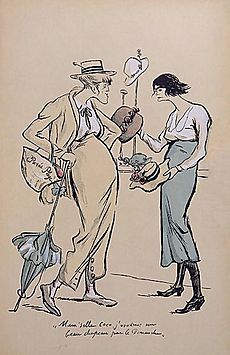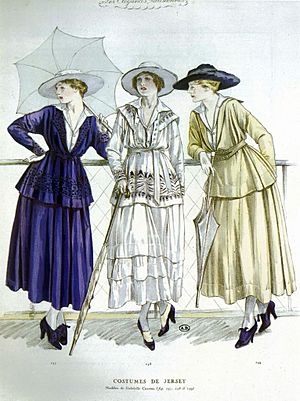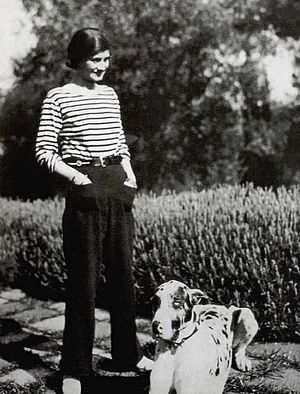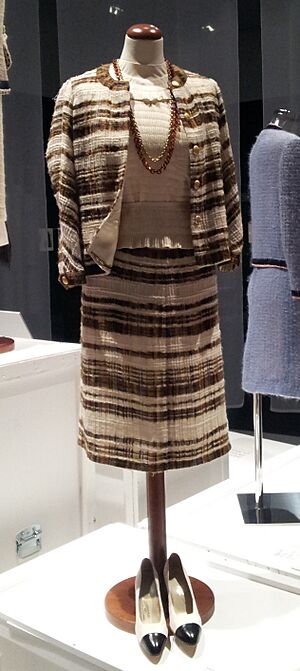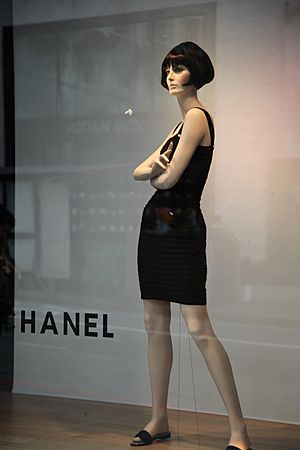Coco Chanel facts for kids
Quick facts for kids
Coco Chanel
|
|
|---|---|
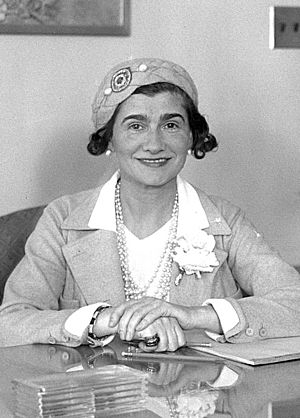
Chanel in 1931
|
|
| Born |
Gabrielle Bonheur Chanel
19 August 1883 Saumur, France
|
| Died | 10 January 1971 (aged 87) Paris, France
|
| Resting place | Bois-de-Vaux Cemetery, Lausanne, Switzerland |
| Occupation |
|
| Known for |
|
|
Label(s)
|
Chanel |
| Awards | Neiman Marcus Fashion Award, 1957 |
Gabrielle Bonheur "Coco" Chanel (pronounced shə-NEL; born August 19, 1883 – died January 10, 1971) was a famous French fashion designer and businesswoman. She created the well-known Chanel brand. She made sporty, comfortable, and stylish clothes popular for women.
Coco Chanel is the only fashion designer on Time magazine's list of the 100 most important people of the 20th century. She also designed jewelry, handbags, and perfumes. Her most famous perfume, Chanel No. 5, is still very popular today. Chanel also designed her famous interlocking-C logo, which has been used since the 1920s.
Her fashion house closed in 1939 when World War II began. Chanel stayed in France during the war. After the war, she was questioned about her connections during that time, but she was not charged. When the war ended, Chanel moved to Switzerland. She returned to Paris in 1954 to open her fashion house again.
Contents
Coco Chanel's Early Life
Gabrielle Bonheur Chanel was born in 1883 in a charity hospital in Saumur, France. Her mother, Jeanne Devolle, was a laundrywoman. Her father, Albert Chanel, was a street vendor. He traveled a lot to sell clothes. The family lived in small, crowded places.
When Gabrielle was 11 years old, her mother died at age 32. Her father sent his two sons to work on farms. He sent his three daughters, including Gabrielle, to a convent that ran an orphanage in Aubazine. Life there was very strict. This is where Coco learned to sew, which was a very important skill for her future.
When she was 18, Coco was too old to stay at the orphanage. She moved to a boarding house for Catholic girls in Moulins. Later in her life, Coco often told different, more exciting stories about her childhood, which weren't always true.
Starting Her Journey in Fashion
From Seamstress to Singer
After learning to sew at Aubazine, Coco found a job as a seamstress. When she wasn't sewing, she sang in a cabaret, which was a type of entertainment venue. She performed at La Rotonde in Moulins. She was a "poseuse," meaning she entertained the crowd between the main acts.
It was during this time that Gabrielle got the nickname "Coco." She often sang a song called "Who Has Seen Coco?" She liked to say her father gave her the nickname.
Meeting Key People and Opening Her First Shops
In Moulins, Coco met Étienne Balsan, a wealthy former soldier. She lived with him for three years. Balsan gave her many fancy things like diamonds and pearls.
While living with Balsan, Coco started designing hats. What began as a hobby soon turned into a business. In 1910, she became a licensed hat maker and opened her first shop in Paris called Chanel Modes. Her hats became very popular after a famous actress, Gabrielle Dorziat, wore them.
In 1913, Coco opened another shop in Deauville, France. This shop was paid for by Arthur Capel, a friend she met through Balsan. Here, she started selling comfortable, casual clothes for sports and leisure. She used simple fabrics like jersey, which was usually used for men's underwear. Her sister Antoinette and aunt Adrienne helped her by modeling the clothes around town.
Coco wanted to repeat her success, so she opened another shop in Biarritz in 1915. This business also did very well. By 1919, Chanel was known as a couturière (a high-fashion designer) and opened her main fashion house at 31 rue Cambon in Paris.
Becoming a Famous Designer
In 1918, Chanel bought the building at 31 rue Cambon, in a very fashionable part of Paris. In 1921, she opened a fashion boutique there. It sold clothes, hats, and accessories. Later, she added jewelry and perfumes. By 1927, Chanel owned five buildings on rue Cambon.
Designing for Movies
In 1931, Coco Chanel met Samuel Goldwyn, a famous Hollywood movie producer. He offered her a lot of money to design costumes for his movie stars in Hollywood. Chanel agreed to the offer.
She designed clothes for actresses like Gloria Swanson and Ina Claire. Famous stars like Greta Garbo and Marlene Dietrich also became her private clients. Chanel also designed costumes for several French films, including La Règle du jeu in 1939.
Life During World War II
In 1939, when World War II started, Chanel closed her shops. She said it was not a time for fashion. She continued to live in her apartment above her fashion house in Paris. During the German occupation of Paris, she stayed at the Hotel Ritz.
Returning to Fashion and Later Life
In 1945, Chanel moved to Switzerland and lived there for several years. When she was over 70 years old, after her fashion house had been closed for 15 years, she decided to return to the fashion world.
Her comeback collection in 1954 was a big success, especially with the American and British press. They saw it as a new way to combine fashion and youth.
Her Final Days
In early 1971, Coco Chanel was preparing her spring collection. On January 9, she felt ill and went to bed early. She died on Sunday, January 10, 1971, at the Hotel Ritz, where she had lived for over 30 years.
Her funeral was held in Paris. Her fashion models sat in the front, and her coffin was covered with white flowers. Many famous people attended her funeral. She was buried in the Bois-de-Vaux Cemetery in Lausanne, Switzerland.
Chanel's Fashion Legacy
Coco Chanel created many designs that are still popular today.
Jersey Fabric
One of Chanel's early designs was a comfortable wool jersey traveling suit. It had a cardigan jacket and a pleated skirt, worn with a simple top. This outfit, with low-heeled shoes, became a popular casual style for women.
The Chanel Suit
First made in 1923, the Chanel tweed suit was designed to be comfortable and practical. It had a jacket and skirt made of soft, light wool or tweed. The lining was made of jersey or silk. Chanel did not use stiff materials or shoulder pads, which was common at the time. This allowed for easy movement. She also designed the neckline to be comfortable and added useful pockets.
The Little Black Dress
The idea of the little black dress is often credited to Chanel. It is a style that is still worn today. In 1912–1913, actress Suzanne Orlandi was one of the first to wear a Chanel little black dress. In 1920, Chanel herself said she wanted to dress all women in black.
The Chanel Bag
In 1929, Chanel introduced a handbag inspired by soldiers' bags. It had a thin shoulder strap, which allowed the wearer to keep her hands free. After her comeback, Chanel updated the design in February 1955. This new bag became known as the "2.55" (named after the date it was created). Even though some details have changed over time, the bag has kept its original basic shape.
Coco Chanel in Popular Culture
Theatre
- The Broadway musical Coco opened in 1969. It was about Chanel re-opening her fashion house. Katharine Hepburn played Coco Chanel in the show.
Film
- Chanel Solitaire (1981) was one of the first films about Chanel.
- Coco Chanel (2008) was a TV movie starring Shirley MacLaine as the older Chanel and Barbora Bobuľová as the young Chanel.
- Coco avant Chanel (2009) was a French film about Coco's early life, starring Audrey Tautou.
- Coco Chanel & Igor Stravinsky (2009) was another French film, based on a novel about a rumored affair between Chanel and the composer Igor Stravinsky.
Famous Quotes by Coco Chanel
- "The best colour in the whole world is the one that looks good on you."
- "Keep your heel, head and standards high."
- "Everyday is a fashion show and the world is the runway."
- "The best things in life are free. The second best things are very, very expensive."
- "Fashion comes and goes but style lasts forever."
- "To be irreplaceable, you have to be different."
- "Beauty begins the moment you decide to be yourself."
Images for kids
See also
 In Spanish: Coco Chanel para niños
In Spanish: Coco Chanel para niños



